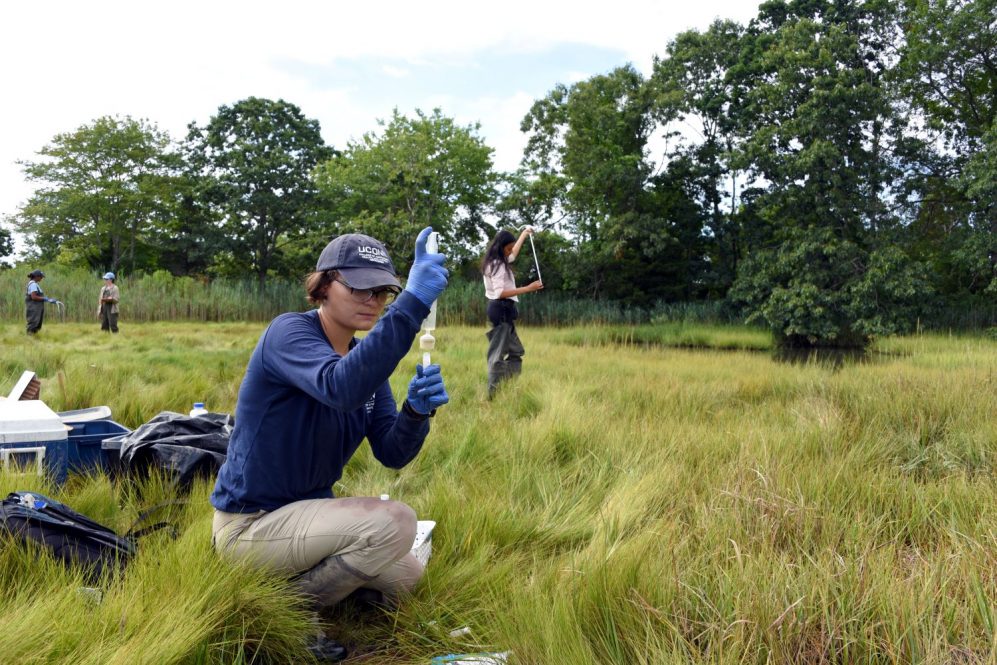This summer, Madeline Kollegger ’25 (CAHNR) will be spending plenty of time near the coast, but she won’t be there to swim or sunbathe. The second-year Ph.D. student in the Department of Natural Resources and the Environment is working to find the best way to protect Long Island Sound’s marshes from sea level rise.
Between 1986 and 2010, Long Island Sound faced sea level rise of about five centimeters. This may not seem like much, but projections estimate this region could face a 50-centimeter rise by 2050.
Marshes would be particularly hard hit if this comes to pass. Marshes provide habitat for many unique species, protection against storm surges, and pollution filtration. Local communities and ecosystems would be impacted significantly.
This is a particularly pressing problem for Long Island Sound as the area is developed right up to the marshes. In less-developed areas, marshes can naturally push inland as sea level rises. Along the Sound, these marshes have nowhere to go.
“All of these natural spaces are drowning as sea level rises and because humans have developed our coast lines right up to the water’s edge. There’s no space for the natural marsh to move inland, and houses are at risk from sea level rise and storm surges,” Kollegger says. “That’s really what we’re looking at – how can we protect those coastal marshes and restore them so that they are not drowning as sea level rises and they provide better barriers to storm surge for development.”
This project, funded through the Long Island Sound Study, is a collaborative effort between the labs of Kollegger’s advisor, Ashley Helton, associate professor of natural resources and the environment; Beth Lawrence, associate professor of wetland and plant ecology; and Chris Elphick, professor in the Department of Ecology and Evolutionary Biology.
This team is testing a restoration method known as thin layer placement. By placing a thin layer of sediment on top of a marsh, researchers gradually increase the elevation of the marsh against sea level rise.
“If you add a thin enough layer of sediment the plants can all grow right through that sediment and it’s still really strong and resilient,” Kollegger says. “What we’re finding is that this really works.”
Thin layer placement is a relatively new method that has been used in the Gulf of Mexico where wetlands loss has been more rapid. Typically, people use dredge material scooped up from the bottom of marinas or channels.
“It’s really easy and cheap because it’s right near those marshes, so [people] don’t have to truck it in from anywhere,” Kollegger says.
This project is investigating what alternatives are effective. The research team is testing a series of sediments of various grain sizes like sand, cobble, and loam.
Kollegger measures indicators like how long it takes plants to regrow after the thin layer placement and how many plants regrow. The researchers also take samples to measure changes in water chemistry and greenhouse gases.
To measure greenhouse gases, Kollegger uses the “static chamber method” which uses a PVC tube placed on the ground and capped to capture the gases coming off the ground. This allows researchers to measure the rate of accumulation of greenhouse gases.
“We’re not sure how restoring a marsh is going to change the greenhouse gases and how they cycle through the wetlands,” Kollegger. “There could be more carbon storage, or there could be more release of carbon in the form of greenhouse gases. We’re really just looking to see how it’s changing when we restore.”
Kollegger says the ultimate aim of this project is to gather enough information to provide guidance to the agencies managing Connecticut’s marshes on how they can best protect these critical ecosystems against the impacts of climate change.
“We’re hoping to provide managers with more information and detail on how they can have those restoration outcomes that they want to succeed,” Kollegger says.
This work relates to CAHNR’s Strategic Vision area focused on Advancing Adaptation and Resilience in a Changing Climate.
Follow UConn CAHNR on social media



